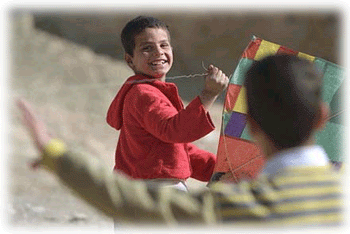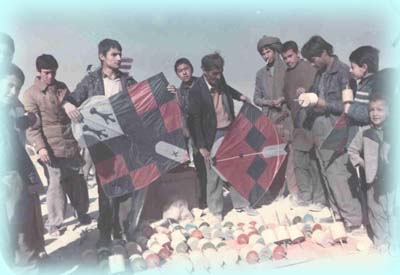
Kite flying ګودى پران بازى (Gudiparan Bazi - literally translated as “Flying Doll Play”) is a very popular sport in Afghanistan, as highlighted in the movie, The Kite Runner.
The kites are flown very high, easy on a day when the wind is a sure thing. It looks beautiful and calm until an opponent comes along . Unlike the soft, white, cotton kite string of your childhood, Afghan string comes in black, brown, hot pink, deep purples, and reds. The string is like a fine sandpaper to the touch -- with glass or sand encrusting what looks like monofilament. It's designed to cut the opponent's line and send the kite floating to earth, defeated.
"Every winter, districts in Kabul held a kite-fighting tournament. If you were a boy living in Kabul, the day of the tournament was undeniably the highlight of the cold season. I never slept the night before the tournament. I felt like a soldier trying to sleep in the trenches the night before a major battle. And that wasn't so far off. In Kabul, fighting kites was a little like going to war" (Hosseini, The Kite Runner, p.43)
The following article on kite flying was found at http://www.afghana.com/Entertainment/Gudiparanbazi.htm
Before the war began, Gudiparan bazi was a common hobby of many Afghans throughout Afghanistan. It was a form of sport that many elevated to an art form. From the designs and sizes of the kites to the making of unbreakable tar (wire), for many people, this became a matter of honor. People would compete to see who was the best kite fighter in the neighborhood. This addicting sport absorbed many young Afghans, even during the war. For those who missed out on this great Afghan pastime, here is the nuts and bolts of Afghan kite and kite fighting in a nut shell. I have compiled this article to preserve this aspect of the Afghan culture, as today this sport is banned by current authorities
The Team
It was generally accepted that to fly a kite, 2 people were required. One to actually fly the kite (leader) and the other to keep the charkha (an intricately designed wooden spool used for winding the wire on). Many times the "charkha gir" (person holding the string) would get the blame for not holding the wire correctly should their kite lose the fight.
The Kite
The kites came in different sizes - from the smallest (only about 10-12 inches in diameter) to the largest which was human size - with Dari names such as 'Mahi gec', 'nim takhtai' (half board), 'se parcha', 'panj parcha', 'shesh parcha' and the famous gigantic "haft parcha" or simply "haft". The shape was mostly conserved throughout the family of Kites. They were all made of thin paper and bamboo wood, due to its malleability and flexibility.

The Wire (Tar)
The 'wire' or kite string was very important. Much attention was paid to this aspect, as it determined the success of Kite fighting. A variety of strings and wires were used. The thinner strings worked well when flying small kites. Many advocated this due to its fine ability to get into the opponents wire easily and cut it during a kite fight. Preparing the wire took hours. First glass was ground up, and mixed with glue and mushed rice. This mixture was called "shisha" and was used to coat the string. After it was dry, it was wound around the spool (charkha), where it was stored for use. The alternative coating method was called "dolai", where the wire was immersed into liquid "shisha" and coated. It was left to dry, then used. Usually 2 trees were used to wound the wire around until it was dry, then wound on a spool (Charkha). Due to the crushed glass, many children would cut themselves - often to the bone. To avoid this, many wrapped a piece of leather around their index finger (called kilkak) to protect them.
The Drum/Spool (Charkha)
Though charkha was mostly used for storage of wire, it proved crucial during kite fighting where rapid release of wire was critical. It was essential to have the drum light for ease of use, so wood was used to make this element of kite flying.
The Fight (Jang)
The fight begins when the wires of two kites come in contact with each other. The fight could last anywhere between a split second to up to 1/2 hour, depending on wind, the difference in string quality between the two parties and other undetermined factors. The general concept was to release wire, and avoid pulling when in a kite fight. The faster you release the more likely one would win the fight. This theory is based on a complex dynamic relationship of the wires while in the air, which held true for the most part. Since larger kites had greater pull, greater release of wire per second was anticipated and thus greater chance of winning with a larger kite. However larger kites have been known to lose to much smaller kites. The quality of 'tar' was also an important factor in determining who was to go home with a kite. Some would preach that the smoother the wire, the better it would cut the opponent, as it would be more fluid during the fight. Further, the wire with more shisha (glass) would get stuck easily and get cut. However, proponents would argue that sharper wire would serve better specially during "kashak" (a fight where one of the parties go on offense and pull very hard under the opponent - this fight would last no more than a second usually). Though there is no research into the topic, somewhere in between is probably where one wants to be.
Azadi Rawast
Azadi Rawast
If someone's kite string gets cut, it flies off without guidance or direction and is therefore a great opportunity for some one else to catch and own it.
The Sharti
The Sharti
Most Kocha's (A block of street) had their own Sharti (Kite fight Champion). Sharti title was given to the one who had the impeccable record of not losing a kite fight. Shartis generally had a good grasp of what they should do in a particular kite fight to win, or at least not lose. They also had a style and elegance that would capture an audience throughout the neighborhood. However, even sharti's would occasionally lose, and this was generally a big deal to many kochagis (neigborhoods).
The Hazards
Unfortunately kite flying in Afghanistan was a dangerous business. For the most part this was a boy's game. Flying kites in neighborhoods meant one would climb the roof, where they had the best view and access to wind and skies. However, this also led to a lot of children breaking bones or even losing their lives.

I just finished reading the wonderful novel "The Kite Runner" by Khaled Hosseini, that brought back memories of my childhood. As a kid the same age as Amir & Hassan, back in the 1950s, I enjoyed Kite making & kite flying. I enjoyed this excellent article also.
ReplyDelete